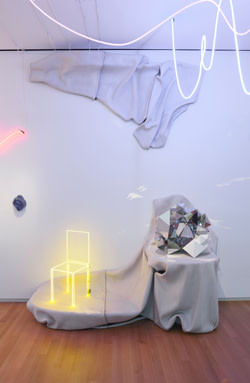New York as capital of craft
Simply sign up to the Life & Arts myFT Digest -- delivered directly to your inbox.
If you asked people what sorts of things get made in New York, the most common answer would probably be “deals”. The city, which in the middle of the 20th century was still the world’s biggest manufacturing centre, has staked its identity on more vaporous products: TV shows, novels, news and, of course, all those financial abstractions that go flitting around the ether but exist almost exclusively as digits on a screen.
But in the first instalment of a planned biennial entitled NYC Makers, the Museum of Arts and Design (MAD) describes a more artisanal New York, full of workshops, studios, kitchens and factory floors that turn out tangible (or often digestible) objects. To MAD, the metropolis teems with “makers”, artisans who hunch over their worktables quietly lathing and casting and shaping and snipping just like their predecessors did, but who are also busy fabricating tomorrow’s New York. As the museum’s new director Glenn Adamson puts in his catalogue foreword, “the ongoing vitality of the city’s creative economy rests in their hands”.
What is astonishing about NYC Makers is that a provocative point can be so incoherently argued. The exhibition is a mess. A passel of cultural luminaries (David Byrne, Marina Abramovic, and so on) was invited to contribute ideas, making an ostensibly populist process in fact wildly elitist: the city’s shakers anointing its makers. They nominated 400 individuals and collectives; the museum selected 100, just enough to turn two floors of galleries, stairwells and elevators into an overflowing grab-bag of displays.
There was an opportunity here to uphold small-batch creativity as an antidote to the volume, efficiencies and speed that characterise a global city. The Brooklyn Navy Yard, for instance, where tens of thousands of workers once assembled battleships, now hosts a range of specialised mini-factories, producing everything from decorative plasterwork to high-tech combat clothing. The Garment District no longer churns out a nation’s ready-to-wear wardrobes, but it does still harbour a colony of designers who need to be near stores selling buttons, fabrics, ribbons and rhinestones. Manufacturing lives on here, in quirky forms and hidden ateliers, and MAD does showcase various items – plumed hats, a bishop’s robe, a bottle of bourbon – testifying to that astonishing endurance.
But the curators never marshal their evidence into an account of an industrious city, or explain how the present relates to the future or the past. They dispense with text panels or labels and instead leave viewers stranded in the overflowing galleries with nothing but a cryptic crib sheet for a guide. (The museum is apparently rethinking that approach.)
“Confusing” doesn’t begin to describe the installation. In Or Zubalsky’s “Meeting Table”, a big bass drum fitted out with sensors reads visitors’ heartbeats by means of a stethoscope and then translates them into sound. Flavor Paper’s scratch-and-sniff wall covering makes the stairwells stink like glossy magazine inserts.
These semi-memorable moments compete for attention with a cornucopia of bric-a-brac. We wander uncomprehendingly among red plastic mannequins, terrariums, neon signs, architectural miniatures memorialising disasters, sound pieces, musical instruments, papier-mâché models of an explorer’s gear and much, much, much more.
This abundance is encouraging in theory but demoralising in the context of a museum that quickly loses track of what it’s trying to say. The show celebrates jewellers, luthiers, carpenters, metalworkers, costumiers and distillers – a whole neo-retro spectrum of ancient crafts now being practised across the five boroughs. It also includes genuine, only-in-New York miracles of handiwork, like a section of gilded filigree from the Metropolitan Opera’s production of Die Fledermaus. (The Met is a practically monastic force in the preservation of old trades.)

But the exhibition also includes more puzzling entries, such as a Yoko Ono video, a Meredith Monk musical score and a “pneumatically powered kinetic sculpture” by Arnaldo Morales, which looks like a cross between a racing car and a hospital gurney, equipped with an air compressor that in theory makes the thing pump and bounce like a souped-up low rider. Yes, all these things were made in New York, but by including them the museum has stretched an already very big tent to the point of collapse.
The show also doesn’t grapple with the fact that New York’s new generation of artisan/industrialists, eking out goods the same way their great-great-grandparents did on the Lower East Side (minus the child labour), are powered by heavy doses of silliness. Can the drudgery of taking computer-graded exams really be ennobled by filling in ovals with a hand-carved No. 2 pencil? Are urban lumberjacks more likely to hew their own logs with a $350 Best Made Company hand-painted axe (corporate mission: “We seek to empower people to get outside, use their hands and in doing so embark on a life of fulfilling projects and lasting experiences”) than with a $50 number from Home Depot?
It’s true that from antiquity onwards, civilisations have adorned their tools, turning basic utilitarian gizmos into imperishable artworks. But MAD’s mad artisans have taken that idea one step farther, elevating basic foodstuffs into exquisite ephemera. We’re not talking fancy cookery here – chefs, it seems, don’t qualify as “makers” – but coffee and candy.
Brewing up a dose of drinkable caffeine has become a form of performance art: baristas at Blue Bottle Coffee (corporate admonition: “water that’s too hot, a hurried pour or even an offhand remark might wither its complexity”) administer trickles of 190-degree water to their precious grounds, yielding a cup that is reasonably tasty, unreasonably tepid, and shockingly priced. NYC Makers boils all this wizardry down to a puzzlingly terse display: a little pile of generic-looking coffee beans. In the end, the picture that emerges from this argumentative exhibition is a rather precious diorama of self-absorbed elves, fashioning bespoke merchandise for those who can afford such postindustrial authenticity.
madmuseum.org, to October 12
Comments